
Alabama Agricultural and Mechanical University is a public historically black land-grant university in Normal, Alabama. Founded in the 1875 as a normal school, it took its present name in 1969. AAMU is a member-school of the Thurgood Marshall College Fund and is accredited by the Southern Association of Colleges and Schools. Alabama Agricultural and Mechanical University Historic District, also known as Normal Hill College Historic District, has 28 buildings and four structures listed in the United States National Register of Historic Places.

The Martin Luther King Jr. National Historical Park covers about 35 acres (0.14 km2) and includes several buildings in Atlanta, Georgia related to the life and work of civil rights leader Martin Luther King Jr. Within the park is his boyhood home and the original Ebenezer Baptist Church, the church where King was baptized and both his father Martin Luther King Sr. and he were pastors.

The Burns Club of Atlanta, officially organized in 1896, is a private social club and literary and cultural society commemorating the works and spirit of the 18th century national poet of Scotland, Robert Burns. In addition to holding monthly meetings, the club has held a Burns supper celebration on the anniversary of Burns' birthday every year since 1898. Club events are held in the Atlanta Burns Cottage, a 1911 replica of poet Robert Burns' birthplace in Alloway, Ayrshire, Scotland. The Cottage has been listed on the National Register of Historic Places as Burns Cottage since 1983.
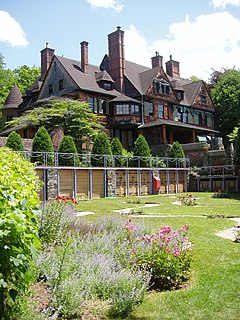
Naumkeag is the former country estate of noted New York City lawyer Joseph Hodges Choate and Caroline Dutcher Sterling Choate, located at 5 Prospect Hill Road, Stockbridge, Massachusetts. The estate's centerpiece is a 44-room, Shingle Style country house designed principally by Stanford White of McKim, Mead & White, and constructed in 1886 and 1887.

The Auburn University Chapel is the second-oldest building and oldest building in its original location on the campus of Auburn University in Auburn, Alabama.

The Ebenezer Missionary Baptist Church is a church on the National Register of Historic Places in Auburn, Alabama. Ebenezer Baptist Church was the first African American church built in the Auburn area after the end of the Civil War in 1865. Over the next few years, the church members built the church out of hand-hewn logs, transported from miles away by mules. The church was completed around 1870 and served the Ebenezer congregation until 1969. The building was restored in 1970 by the Auburn Heritage Association, and currently houses the Auburn Unitarian Universalist Fellowship.

Noble Hall, also known as the Frazer-Brown-Pearson Home, is a historic Greek Revival style plantation house in Auburn, Alabama. It was listed on the National Register of Historic Places on March 24, 1972.

Pebble Hill, also known as the Scott-Yarbrough House, is an antebellum cottage in Auburn, Alabama listed on the National Register of Historic Places. It currently serves as the location of the Caroline Marshall Draughon Center for the Arts & Humanities in the College of Liberal Arts at Auburn University.

St. Luke's Episcopal Church is a historic Carpenter Gothic church, built during the 1850s at Cahaba, the first capital of Alabama from 1820 to 1826. The unknown builder closely followed plans published by architect Richard Upjohn in his 1852 book Rural Architecture.
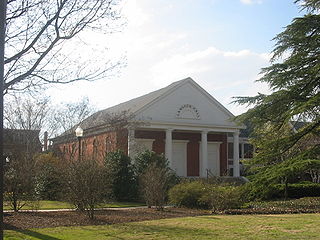
Langdon Hall is a building on the campus of Auburn University in Auburn, Alabama, United States. Built in the Greek Revival style in 1846 as the chapel for the Auburn Female College and moved to the Auburn University campus in 1883, Langdon Hall is the oldest building in the city of Auburn, and today houses an auditorium and office space for Auburn University staff. Before the Civil War, Langdon Hall served as the location for a series of debates on the question of Southern secession, involving William Lowndes Yancey, Alexander Stephens, Benjamin Harvey Hill, and Robert Toombs. Langdon Hall is named for Charles Carter Langdon, a former mayor of Mobile, Alabama, Alabama Secretary of State, and a trustee of Auburn University from 1872–1889.
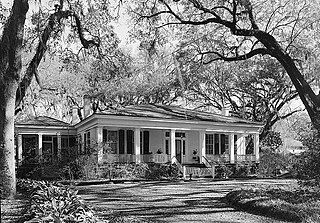
Georgia Cottage, also known as the Augusta Evans Wilson House, is a historic residence in Mobile, Alabama, United States. It was added to the National Register of Historic Places on September 14, 1972, based on its association with Augusta Jane Evans. She was one of the most popular American novelists of the nineteenth century and the first female author in the United States to earn over $100,000 for her work, but has been largely forgotten in recent times.

The Ross Knox House is a historic Tudor Revival style residence in Mobile, Alabama, United States. The two-story brick and stucco house was completed in 1929. It is considered one of the best Tudor Revival houses in Mobile by the Alabama Historical Commission. Built in the 1920s upper-class suburb of County Club Estates, it was designed by architect John Platt Roberts.
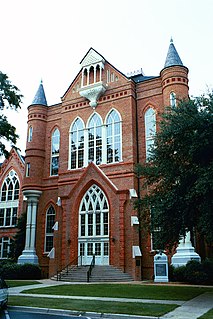
The Gorgas–Manly Historic District is a historic district that includes 12 acres (4.9 ha) and eight buildings on the campus of the University of Alabama in Tuscaloosa, Alabama. The buildings represent the university campus as it existed from the establishment of the institution through to the late 19th century. Two buildings included in the district, Gorgas House and the Little Round House, are among only seven structures to have survived the burning of the campus by the Union Army, under the command of Brigadier General John T. Croxton, on April 4, 1865. The other survivors were the President's Mansion and the Old Observatory, plus a few faculty residences.

The Gerald-Dowdell House was built ca. 1854 by Perley and Camilla (Sanford) Buckley Gerald. Perley Gerald, a native of New York, moved to Alabama in 1829, first settling in Mobile before moving to the Montgomery area to trade with the Creek Indians. During the Gold Rush of 1849, Gerald went west and made a fortune trading with the miners. He later married Camilla Sanford Buckley, whose brother was General John Williams Sanford of Georgia and whose nephew was Colonel J.W.A. Sanford, Jr., who designed the State flag.

Auburn City Hall in Auburn, Alabama, built in 1933, is the city hall of Auburn, Alabama. It was originally constructed as a post office in 1933, and, like many post offices constructed during the Great Depression, the building has a "starved classical" design typical of federal architecture, with symmetrical style and pointed pediments and elements of colonial revival architecture. It was listed on the National Register of Historic Places as the U.S. Post Office in 1983.

The Wilson–Finlay House, also known as Mist Lady, the Joshua Wilson House, and the Finlay House, is a historic plantation house in Gainestown, Alabama. It was added to the Alabama Register of Landmarks and Heritage on September 17, 1976. It was placed on the National Register of Historic Places on July 12, 1978, due to its architectural significance.

The Cottage Home Historic District is a historic district and neighborhood located on the near east side of Indianapolis, Indiana. A small portion of Cottage Home is listed on the National Register of Historic Places while a larger area is listed on the state and local levels. Known for its preponderance of "cottage-style" homes built with strong Victorian influences, Cottage Home has historically been a working class neighborhood. Numerous industrial buildings are also scattered throughout the district, providing a base of economic activity. Today, however, many of these buildings are vacant, providing a special challenge to preservation and urban renewal efforts.

The Bankhead House, also known as Sunset and the John Hollis Bankhead House, is a historic mansion in Jasper, Walker County, Alabama. It was added to the National Register of Historic Places on June 18, 1973.
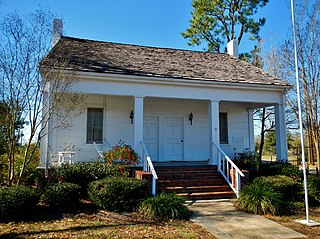
The Kennedy House is a historic residence in Abbeville, Alabama. The house was built around 1870 by William Calvin Bethune, a local physician. The house changed hands several times before being acquired by William and Mollie Kennedy in 1885. The Kennedys, who were Henry County farmers, used it as a town house. It remained in the family until 1974, when it was purchased by the local Board of Education. The house was later owned by the Abbeville Chamber of Commerce.




















